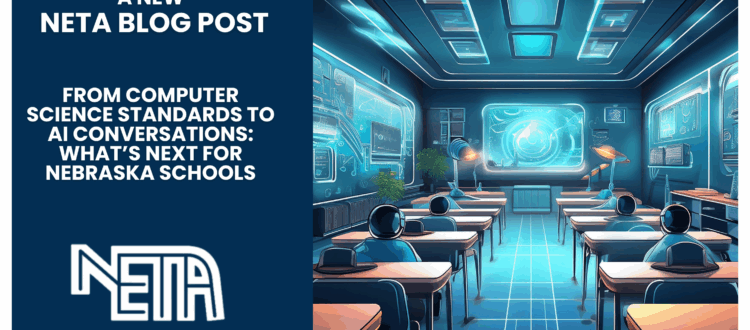From Computer Science Standards to AI Conversations: What’s Next for Nebraska Schools
Written by: Shaun Young
For the past two years, my role as the Computer Science and Technology Education Specialist at the Nebraska Department of Education has revolved around helping schools prepare for something significant, and at times daunting – the rollout of our state’s new computer science graduation requirement. We’ve worked side by side with districts to align courses, train teachers, and make sure students across Nebraska can graduate ready for a future that continues to become more digital.
And just as schools are beginning to feel settled with these new expectations, the conversation is shifting again. This time, it’s not just computer science at the center of attention—it’s artificial intelligence.
Even Code.org, one of the most influential organizations in K–12 computer science education, is pivoting significant energy toward AI. That signals something bigger: the national conversation about “computing” is broadening. And Nebraska schools, teachers, and tech coordinators will have to decide how to balance both realities—meeting the requirement we just put into place, while preparing for the next wave.
Why the Shift Matters
AI isn’t replacing computer science—it’s reframing it. A student who learns to code is building the mental models to understand algorithms, logic, and problem-solving. Those skills are exactly what’s needed to think critically about how AI works, what it does well, and where it fails.
But if AI is becoming the new focus, the practical questions for schools are clear:
- Budget: Can schools afford to expand professional development, devices, and digital tools to cover AI on top of CS? What will administrators need to prioritize?
- Professional Development: Teachers have just started getting comfortable with CS standards. Do we have the bandwidth—and resources—to prepare them for AI literacy too?
- Curriculum: Should AI be embedded into existing CS courses, or treated as a cross-disciplinary literacy for all teachers, like digital citizenship?
- Equity: Rural and under-resourced schools, already stretched to meet the CS requirement, risk falling further behind if AI learning depends on cutting-edge tools and connectivity.
What Schools Can Do Now
The best path forward isn’t to abandon computer science for AI. It’s to recognize how the two complement each other. Schools can start by:
- Building teacher confidence: Invest in PD that doesn’t just introduce AI tools but helps teachers model ethical and thoughtful use for students.
- Framing AI as applied CS: Show students how the programming and logic they learn in CS class connects directly to how AI systems are built and evaluated.
- Planning budgets with flexibility: District leaders and tech coordinators should anticipate AI-related costs in the next budget cycle—whether for training, devices, or licensing.
- Encouraging cross-disciplinary connections: AI isn’t just for CS classrooms. English teachers exploring authorship, social studies teachers debating bias, and science teachers modeling data—all can benefit.
Looking Ahead
The truth is, Nebraska is in a strong position. By requiring CS for graduation, we’ve built a foundation of computational thinking that prepares students to engage with AI critically. But we can’t stop here.
As the national conversation shifts, our schools will need to adapt with intentionality. That means planning for budgets, supporting teachers with PD, and ensuring equitable access—so AI becomes a tool for empowerment, not another source of division.
For educators, this isn’t just “another duty as assigned.” It’s the next chapter in preparing our students for the world they’re already living in. And just like with the CS requirement, Nebraska can lead by showing what’s possible when we invest in both vision and practicality.

